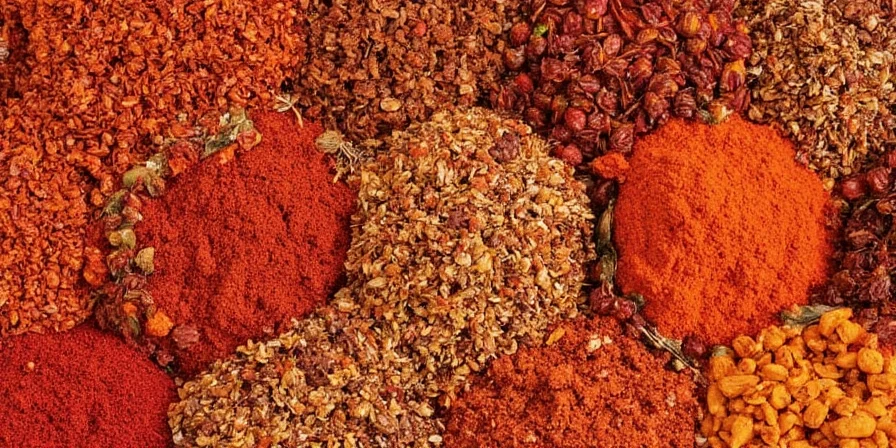7 Italian Herbs That Will Make Your Dishes Sing — A Spicy Journey Through Global Spice Traditions

Description
In this article, we explore the vibrant world of Italian herbs and seasonings, uncovering their roles in traditional dishes, how to use them effectively in your kitchen, and tips for storage and substitution. Perfect for both seasoned chefs and curious home cooks.
Table of Contents
- A Fragrant Introduction to Italian Herbs
- Top 7 Italian Herbs Every Kitchen Should Have
- How to Pair Herbs Like a Pro
- Pro Tips: Storing, Substituting & More
- Global Spice Traditions: How Italy Fits In
- Conclusion: Spice Up Your Life with Italian Flavors
A Fragrant Introduction to Italian Herbs
If you've ever walked through an open-air market in Rome or strolled past a trattoria in Sicily, you know that the aroma of freshly chopped herbs is enough to make your stomach rumble before you even see the menu. Italian cuisine is not just about pasta and pizza—it’s about layering flavor upon flavor, and at the heart of it all are the spices, particularly the humble but mighty herbs.

From the pungent punch of oregano to the earthy warmth of rosemary, Italian herbs bring more than just taste—they add soul. Whether used fresh or dried, these herbs are essential tools in any kitchen looking to capture the spirit of la dolce vita on a plate.
Top 7 Italian Herbs Every Kitchen Should Have
Here’s a list of must-have Italian herbs, along with what makes each special and how they shine in different dishes:
- Basil – The king of pesto, fresh basil brings a bright, sweet flavor perfect for summer dishes like Caprese salad and Margherita pizza.
- Oregano – Robust and aromatic, oregano is a staple in tomato sauces, grilled meats, and Mediterranean stews.
- Rosemary – With its pine-like fragrance, rosemary adds depth to roasted vegetables, lamb, and focaccia bread.
- Thyme – Versatile and subtle, thyme works well in soups, braises, and stuffing recipes.
- Marjoram – Similar to oregano but sweeter, marjoram enhances fish dishes and creamy sauces.
- Parsley – Often used as a garnish, parsley actually contributes a fresh, grassy note when finely chopped into gremolata or tabbouleh.
- Sage – Earthy and slightly peppery, sage pairs beautifully with butter, squash, and sausage.

| Herb | Flavor Profile | Best Used In |
|---|---|---|
| Basil | Fragrant, sweet, slightly peppery | Pesto, salads, pizzas |
| Oregano | Earthy, bold, slightly bitter | Pasta sauces, grilled meats, stews |
| Rosemary | Pine-like, resinous, aromatic | Roasts, focaccia, potatoes |
| Thyme | Subtle, woodsy, citrus undertones | Stews, stocks, poultry |
| Marjoram | Mild, floral, sweeter than oregano | Stuffing, fish, beans |
| Parsley | Grassy, clean, fresh | Garnish, tabbouleh, sauces |
| Sage | Earthy, peppery, herbal | Butter sauces, squash, pork |
How to Pair Herbs Like a Pro
Knowing which herbs play well together can elevate your cooking from good to spectacular. Here’s a quick cheat sheet:
- Basil + Garlic + Olive Oil: A classic trio that forms the base of many Italian sauces.
- Rosemary + Lemon + Thyme: A powerhouse combo for roasted chicken or fish.
- Oregano + Red Pepper Flakes + Fennel Seeds: Great for spicy Italian sausage dishes or hearty tomato sauces.
- Parsley + Lemon Zest + Anchovies: Adds complexity to sauces and pasta dishes.

Pro Tips: Storing, Substituting & More
Whether you’re working with fresh or dried herbs, there are tricks to keeping their flavor strong and their shelf life long.
Storing Fresh Herbs
- Store fresh basil like a bouquet—trim the stems and keep it in a glass of water on the counter.
- For rosemary, thyme, and sage, wrap loosely in a damp paper towel and store in a zip-top bag in the fridge.
- Freeze extra herbs in ice cube trays with olive oil for easy portioning later.
Using Dried Herbs
- Dried herbs are more concentrated than fresh—use about ⅓ the amount called for in a recipe.
- Add dried herbs early in the cooking process (like during sautéing or simmering) to allow flavors to infuse.
When You Don’t Have the Right Herb
- No basil? Try fresh mint or a pinch of dried oregano.
- Misplacing the marjoram? Use thyme or a bit of oregano instead.
- If rosemary is missing, a touch of sage can mimic its earthiness.

Global Spice Traditions: How Italy Fits In
While Italian herbs might not be as fiery as Indian curries or as complex as Moroccan ras el hanout, they have a charm and simplicity that makes them globally loved. Unlike many spice-heavy cuisines, Italian cooking emphasizes quality over quantity—using a few high-quality ingredients to let the flavors shine.
Interestingly, some Italian herbs have roots (literally) in Middle Eastern and Mediterranean traditions. For example:
- Rosemary was used by ancient Egyptians in rituals and medicinal practices before becoming a cornerstone in European kitchens.
- Thyme was used by the Greeks for purification and has made its way into global meat rubs and herbal teas.
- Oregano, though now synonymous with Italian food, originally comes from the eastern Mediterranean and Asia Minor.

This blending of cultures over centuries helped shape what we now recognize as Italian cuisine. And that’s what makes exploring Italian herbs so fascinating—it's a window into history, geography, and the human connection through food.
Conclusion: Spice Up Your Life with Italian Flavors
Italian herbs may seem simple compared to the bold spices of other Global Spice Traditions, but don't be fooled—these little green wonders pack a flavorful punch. From everyday meals to holiday feasts, mastering the use of Italian herbs can take your cooking from basic to brilliant.

So next time you're reaching for salt, maybe grab a pinch of oregano instead. Or whip up a batch of homemade pesto with fresh basil, garlic, and Parmesan. The key is to experiment, savor, and enjoy the journey one herb at a time. After all, isn’t that what living the sweet life—la dolce vita—is all about?











 浙公网安备
33010002000092号
浙公网安备
33010002000092号 浙B2-20120091-4
浙B2-20120091-4